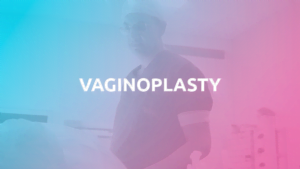
Vaginoplasty is a procedure that transforms male genitals into a functional, aesthetically pleasing vagina and vulva. With Dr Kanhai, patients can expect normal urination, sexual sensation, and minimal scarring.
The ultimate goal of gender-affirming vaginoplasty is a vagina that is secretory, flexible, hairless, approximately 6″ in depth and about 1.5-2″ in diameter, with erogenous sensation and a urethra that enables urination while sitting. To reach this ultimate goal we perform the penile inversion vaginoplasty in combination with a perineo scrotal flap. Also by creating a g-spot, clitoris and lubrication.
Because the vaginoplasty procedure includes removal of the testes (orchiectomy), it is possible to stop or reduce testosterone blockers or reduce oestrogen dose after the procedure.
What to expect
Pre-operative:
- Bring a list of your questions and concerns to your pre-operative visits. Understanding the expectations for recovery, based on your plan, is essential.
- You will need surgery referral letters from two qualified mental health professionals.
- You will be given guidelines on eating, drinking and adjusting current medications before the surgery can take place.
- Smoking is a relative contra-indication to subcutaneous mastectomy. Because of the increased risk of infection i.a., you are advised to stop smoking as soon as possible.
- After you have discussed which surgery technique is best for you, Dr Kanhai will draw up a plan for the operation.
- The anaesthesiologist will provide information on the anaesthesia, and doctor Kanhai about the type of the operation, and the follow-up procedures that might be necessary.
- Dr Kanhai will also ask about any risk factors for blood clotting issues (past deep vein thrombosis or pulmonary embolism), bleeding problems (like haemophilia), or family/personal history of issues with anaesthesia.
- You will undergo a physical examination to ensure readiness for the operation.
- With Dr Kanhai's surgery technique, hair removal before surgery is not necessary anymore.
Peri-operative:
- The surgery is performed under general anaesthesia and will last for approximately 4 hours.
- Penile inversion vaginoplasty is the most commonly performed version of gender-affirming vaginoplasty. It's also the most well-researched. Dr Kanhai’s technique is to combine the penile inversion technique with the perineo scrotal skin flap technique.
- The testicles will be removed and discarded.
- The new vaginal cavity will be created in the space between the urethra, prostate, bladder and the rectum.
- The skin will be removed from the penis. The penile skin, combined with the perineo scrotal skin flap and the g-spot, forms a pipe. The pipe will be inverted and this will become the wall of the cavity.
- An other piece of the glans penis with nerves and blood vessels (the bulbous tip) will be removed to become the clitoris .
- Also creating labia minora and majora.
- The urethra will be removed, shortened, and prepared for repositioning before the remaining parts of the penis are amputated and discarded.
Post-operative:
- On the ward, mobilisation will start the next day. The second day the plastic tubes on the site of the vaginal introitus area will be removed. The gaze will be removed after 7 days, together with the catheter.
- Post-operative pain is normal, and pain medication may be prescribed.
- As with any surgical procedure, there is a period of necessary healing and recovery. The time for healing varies among patients.
- Wash your hands before and after any contact with the genital area. Avoid tight clothing; friction may facilitate transfer of bacteria.
- Vaginal brownish-yellow discharge can be expected in the first 4-6 weeks post-operation. Bleeding and spotting can be expected in the first eight weeks post-operation.
- For the first month post-op, sitting may be uncomfortable but it is not unsafe. You can use a donut ring to relieve pressure at the surgical site.
- Labial swelling is normal and will gradually resolve 6-8 weeks post-operatively. Swelling may be aggravated with long-term sitting or standing. For the first week post-operation, applying ice on the perineum for 20 minutes every hour can assist in relieving some swelling.
- You can resume showering after the first post-operative visit, patting incisional areas dry. Do not take baths or submerge yourself in water for 8 weeks post-operation.
- You have to avoid strenuous activity for 6 weeks. Avoid swimming and bike riding for 3 months. You may resume sexual intercourse 8 weeks after surgery, unless instructed otherwise.
- Dilation of the vaginal sheet is an integral part of recovery. Dilators may be provided to patients with instructions regarding dilation in the post-operative period.

